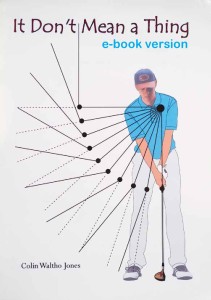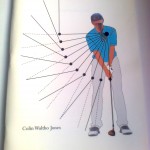Chipping. Your chipping is fine. Your imagination is good, your thinking is clear and your technique is sound enough to get the ball to go where you want it to go. The purpose of practising your chipping tomorrow is NOT to improve what you’ve already got but to see if you can really feel “timing” when you chip. This will come when you are able to find that lovely rhythm which results in a beautiful natural delay at the top of the backswing, when the club has come to a stop but it feels as if it is about to come back to the ball at any second, when you are able to NOT start the downswing but to just wait for the feeling that your hands are approaching the ball, and as they approach the ball that with the softest touch possible you are adding that something special that makes the ball fly to the hole.
To do this you will need to be perfectly relaxed, breathing out and not bedevilled by being attached to some previously held idea of how it is meant to be done. This last point is to try to get you out of the idea that there is a particular method ie “one-piece” take-away. You will naturally take it away in one piece anyway, just stop TRYING to make sure you are taking it away in one piece. RELAX!, your chipping is fine, we just want you to feel the ball sitting on the club and you in perfect control.
————————————————————————————–
As I have said, in my opinion the only thing wrong with your chipping is your confidence as a chipper. The defining issue of chipping is that you can “see” the length. On the one hand this is a huge advantage when it comes to producing an accurate shot (as compared to a 150-yard 7-iron, for instance), on the other hand, being able to “see” the precise distance of the shot is a strong invitation to your conscious to take over the process and the result can be a slightly mechanical swing.
For you, I think that the “mid-range” of imaginative shots presents you with difficulty. You are fine with standard “lob it on and roll it up” shots; you are fine with . . .
——————————————————————————-
[18. A lesson on stickiness.” ]
This practice routine starts with the same exercise but then ends in either of two ways.
The core exercise is designed to get you to look for a pendulumic rhythm that is so perfect that you can feel the ball “sitting” on the blade. I have experienced this phenomenon in all the sports I have played since I discovered the secret of “timing”. It occurs as a sort of “stickiness”; that is, the object being propelled feels, just at the point of impact, as if it is stuck to the club (or racket, or hand etc). A “sticky” shot feels more like a “fling” than a “hit”. “Sticky” shots are always perfect.
Golf is the most difficult game to experience “stickiness”: partly because the club head is made of an inelastic substance and so the collision is relatively inelastic, and partly because the two pendulums that make up the whole motion are so big that they are difficult to synchronise perfectly.
The physics suggests that “stickiness” occurs when the collision is . . .


